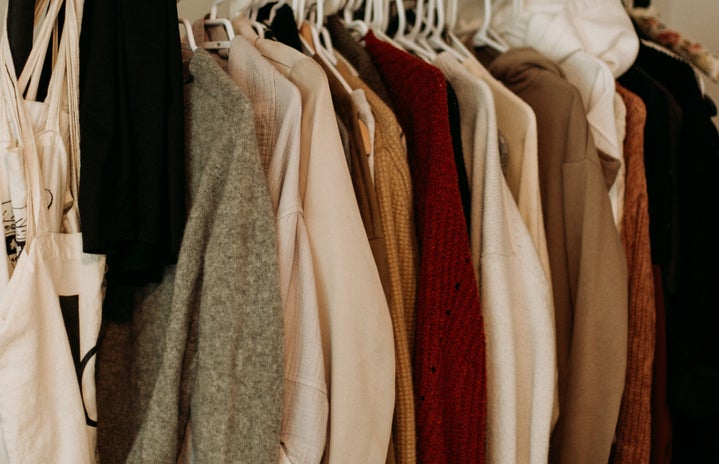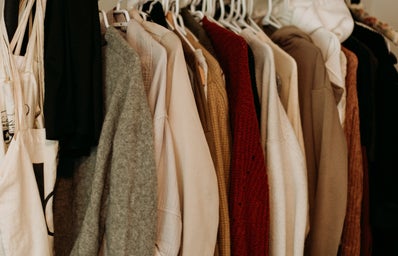It’s no secret that the fast fashion industry has a major toll on the environment, being one of the largest contributors to carbon emissions globally. (If you want to find out more about fast fashion and it’s link to climate change, check out Rosie Bannister’s article here). On the other hand, many sustainable and low carbon alternatives to fast fashion are extremely expensive. As a result, being both fashionable and sustainable may sound impossible on a student budget. However, that really doesn’t have to be the case. To show you just how easy blending a love for the environment and for the fashion world can be, I’ve started up a mini series called ‘Sustainable Styling.’ In this series, other contributors and I will talk about how to achieve a thrifty, ethical and stylish wardrobe!
For the first instalment of this series, I want to dive into the world of minimalist fashion with a specific focus on the capsule wardrobe. The term ‘capsule wardrobe’ has been used in fashion magazines as far back as the 1940s and gained popularity when Susie Faux popularised the term in the 1970s: it essentially refers to a limited collection of clothes intended to be worn together in different combinations and usually are similar in tone and colour, with a focus on quality, longevity, and minimal or classic design. In recent years, capsule wardrobes have taken on a new life and become a staple for the environmentally conscious fashion community. This is because of their ability to help consumers remain fashionable while consuming less.
Capsule wardrobes are a great way to style sustainably for a number of reasons. By limiting our wardrobe they teach us to love the clothes we already have by forcing us to be more creative with different ways of styling them. Capsule wardrobes are also great at teaching us to get comfortable with re-wearing clothes in order to get the full use out of an item, encouraging mindful shopping habits, like investing in a good quality staple piece that is versatile in our wardrobe or limit our spending on fashion pieces by cutting down. It’s a great way to get to grips with what ‘slow fashion’ is really all about: limiting consumption, rewearing items, and investing in well made sustainable pieces which can be worn for a long time. It’s also great for students as it creates an affordable relationship with clothes.
Not only do capsule wardrobes encourage better shopping habits and in turn slow down the economy of fast-fashion, they can also be better for us mentally. A recent study tested ten females on the impact a capsule wardrobe had on them and their results showed “a positive impact of a three-week capsule wardrobe on our participants who felt less stressed, detached from fashion trends, and have found joy in their fashion style.” The study attributes this to the fact that materialism can lead to lower life satisfcation and decision fatique. Essentially, a capsule wardrobe works a lot like Steve Jobs’ decision to wear the same thing every day: by limiting your outfit options, you are able to cut out decisions that don’t matter, and focus on the ones that do (see more on that here).
My advice for starting a capsule wardrobe is:
- Don’t go shopping! The whole point of a capsule wardrobe is to reduce your wardrobe and really focus it down to your favourite pieces. Therefore, going shopping specifically for pieces you want in your capsule wardrobe is completely counter-intuitive! When you first start a capsule wardrobe, it’s best to focus on pieces you already own. That way, you already know if you actually wear that piece.
- Pick what kind of capsule wardrobe you want. Capsule wardrobes can be used in multiple different ways. Some people prefer to have a capsule wardrobe for each season or an event, whilst others rely on a capsule wardrobe for all of their clothing needs and switch out pieces on occasion only.
- Set the tone. As previously mentioned, most capsule wardrobes have a specific style/tone, and these are usually based around your own personal style. If you’re not sure what your personal style is yet, start by laying out your most worn pieces of clothing. In terms of picking a colour palette, you may also want to look into colour analysis to determine what hues suit your skin tone. This research should give you a good indication of what colours and fits you like best, and you can go from there.
- Gather inspiration. Now you have determined from your most worn pieces what colours and moods you lean towards, you can use apps like Pinterest to really narrow down what you want your capsule wardrobe to look like. From here you can pick a colour palette for your capsule wardrobe, and a general vibe (for example, dark academia, parisian chic, 70s aesthetic and so on). Remember, that just because this is a minimalist approach on fashion, you don’t have to fit into minimalsit trend ideas which generally sit on the neautral palette – you can still be bold with your colour choices.
- Split your wardrobe into what fits into the capsule and what doesn’t. Now you know your preferred colour palette and the tone of your capsule wardrobe, you’ll want to sift through your clothing and accesorries to section what could fit into the capsule wardrobe, and what really doesn’t. For items that don’t fit into your desired vibe, consider re-selling, or if you think you will still wear them in the future, store them away.
- Pick your final pieces. At this stage, you’re ready to assemble your wardrobe. To do this, you want to start with interesting statement pieces then look to include the basics you need for layering. Don’t forget to include items you can dress up or down, like a silk dress which could also be used as a top or skirt: these items are what make your wardrobe truly versatile.
- Cut down. Hopefully, after the last step you’ll be left with 35 pieces or less and be good to go. However, from my experience, you’re usually left with a lot more. Be strict with yourself and cut down. And yes – these 35 pieces includes shoes and bags (although they don’t include underwear or workout gear)!
Even if you’re not ready to cut down to a capsule wardrobe just yet, using the principles which capsule wardrobes teach are a great way to start your sustainable fashion journey: for example, minimising your wardrobe and being mindful of overconsumption in your shopping habits.This can also apply to other things in your life. For example, you can cut down your makeup, skincare or haircare so you only have one of each product. If you’re interested in finding out more about capsule wardrobes and minimalism in environmentally conscious fashion communists, some great sources are:
- Books: The Capsule Wardrobe by Wendy Mak, Project 333 by Courtney Carver and How to Break Up With Fast Fashion by Lauren Bravo
- Youtube: A Small Wardrobe , inspiroue and Malama Life
- Podcast: Spark Joy and Too Many Clothes Nothing to Wear
- Blogs: Be More With Less and Sustainably Chic


